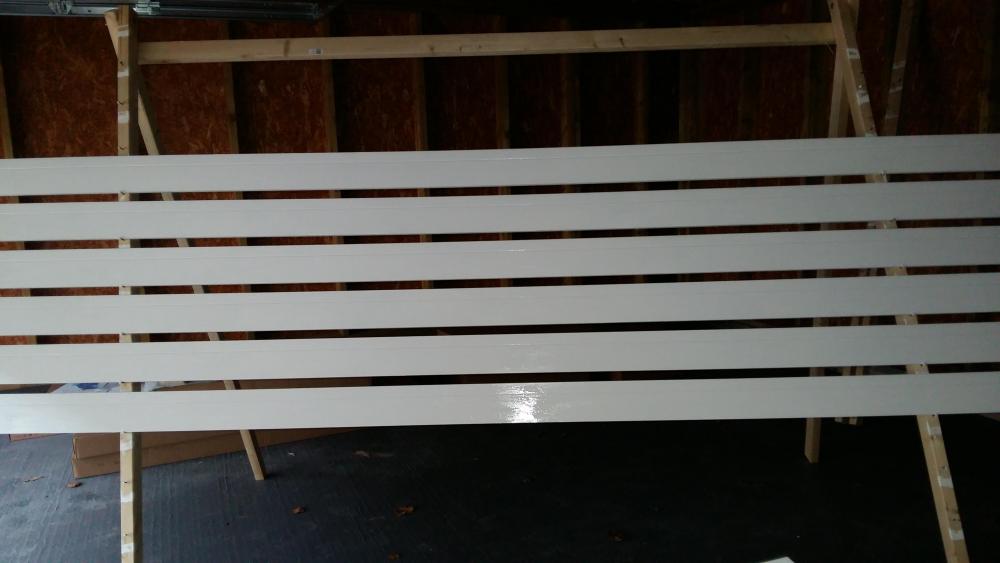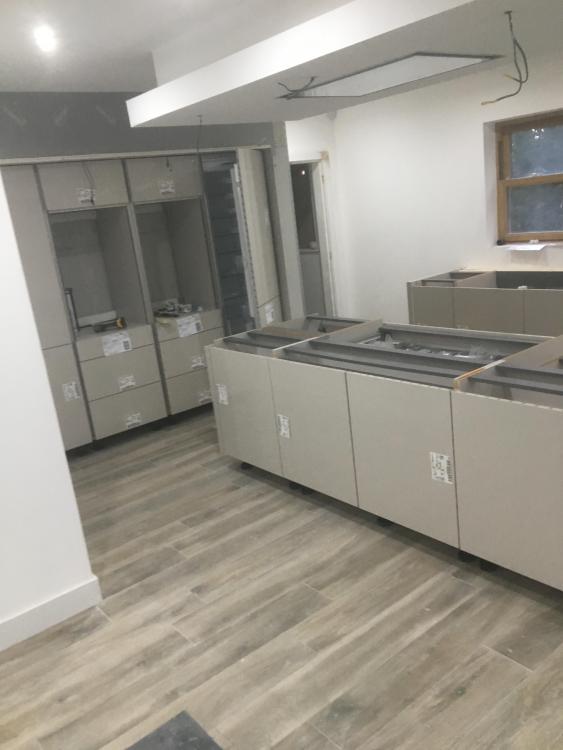Leaderboard
Popular Content
Showing content with the highest reputation on 10/28/18 in all areas
-
In our last blog entry we completed the roof. Guttering was one of those areas in the build that I had never really given much thought to. After doing some research, and asking on here, we came across cast iron effect guttering from Brett Martin. Unfortunately the lead time to get the guttering to Skye was quite long (3-4 weeks). When the outlets and fascias finally arrived, the actual guttering was missing having been lost in transit. We had to order it again, waiting another three weeks for it to get here. Having placed the original order at the end of August the guttering finally arrived last week! Its now up and looks great. Whilst waiting for the guttering we decided to paint the soffits and fascias, putting on a primer first following by a couple of top coats. This took a few weeks, waiting for dry weather windows and painting whenever we got an opportunity. Our joiner fitted some fire stops today and he gave the okay for me to take down the majority of the scaffolding leaving just the gable ends. I was also able to take down the internal bracing. Weather depending the blockwork should be starting week commencing 5th November. Here are some photos of the house.6 points
-
Blimey another month on there is a real sense we are getting there. So much so, we have given notice on our rental. We move in on Friday 30th November regardless! The main emphasis this month has been installing the treatment plant and drainage system. The treatment plant was initially installed, somewhat optimistically, without any anchors only for it to pop back out of the ground within 24hrs, despite being filled with water and the pit filled with pea shingle. Needless to say the second time round, it was anchored down and the pit filled with a lot more concrete than the first time. SEPA – [Scotland] had requested a soak away to be installed along with a 20 metre drainage channel 1.2 metre wide, before connecting to a field drain that eventually discharges into a nearby water course. I then had to register my plant with SEPA at a cost of £137. The local Building Controller arrived on site to test the drains and within 20 minutes or so, both the foul and rainwater systems were passed. As soon as they had been given the all clear, the landscaper and his team set about back filling the trenches and levelling the site ready for a Hammer Head driveway, boundary hedging and turf across the remaining plot. Landscaping can be one of those often forgotten costs and to assist others here are my quantities and material prices. I haven't included the cost of the turf as it is still uncertain as to whether or not it will be laid this year or next. That decision will be taken during the week. Patio mix slabs & single slabs 2265 Setts 540 MOT 3 x 28 tonnes 448 Sand x 6 tonnes 195 Cement x 40 bags 150 Membrane - 60 metres 150 20mm whin stone x 26 tonnes 650 Internally, progress has been frustratingly slow. I had a check of my records and found that the joiner / tiler had only been on site for 11 of the possible past 30 work days!! That said, we now seem to have a momentum building and the floor tiles have started to be laid. This in turn will allow the kitchen units to be fitted this coming week. The electrician will have completed the second fix installation by the end of this coming week and the plumber is booked in for the following week to complete his second fix installations. Once the tiles are down, the joiner will turn his attention to cladding the dormers. So, over the next 4 weeks the following needs to happen – Internally – Floor tile to be laid, grouted and sealed. Kitchen, utility room cabinets to be installed. Fitted furniture in the master bedroom to be fitted. Electrician to complete his second fix and to wire up the pump for the treatment plant. All sanitary ware to be installed. Final bits of internal joinery to be completed. Externally – The gable end stone work to be completed. The dormers to be clad. The porch to be erected. The chimney to be finished off. The landscaping to be completed. Open Reach to connect us to the BT pole outside the plot. What can possibly go wrong ??3 points
-
A few fiddly ones at the bottom stuck on today. All on 1mm packs to achieve the requisite "credit card" distance off the floor:3 points
-
3 points
-
Yes it's very good...black cardomon pods and a splash of vodka make it special2 points
-
Regarding the two use cases - For standard, long term meter readings - good ol Excel at the moment, manual monthly readings. Smart meters due to be fitted in the next few weeks. Live/graphed power usage - Loads of options for 'CT' clamp based monitoring but went for a simple Pi+Hat - http://lechacal.com/wiki/index.php/RPICT3V1 and http://lechacal.com/wiki/index.php/Raspberrypi_Current_and_Temperature_Sensor_Adaptor - I chose this one for simplicity, it presents itself as a serial device on the Pi which I can just open and monitor with a bit of python. This one also seems to be more accurate by reading the actual AC voltage from an AC-AC adapter (but the maths here is beyond me). I like the idea of a 5V bus - I'm getting to the point where I'm starting to use good quality multi port USB chargers now that USB is almost becoming defacto for low voltage peripherals.2 points
-
2 points
-
@Nickfromwales said, @joe90 how warm is the place on just the one 3kW immersion? I take it you have to run it for a good while to get up to temp, eg no on / off-ability to speak of? i have set the immersion to a fairly low temp, 45’?. Yes a whole day to get the house to temp, TRV on the manifold not very accurate (yet to fit the accurate one Jeremy recommended and I bought), water in the manifold at 25’ and house up to 21’ ?, er indoors happy but i know the running cost will fall greatly once the ASHP is up and running (DHW also on immersions currently).2 points
-
Some things are irresistable. This prescient 1903 painting by C. M. Coolidge shows Planning Consultants meeting the Council, even though it is supposedly called "A Friend in Need". With apologies to any highbrow art people on the forum ... this is very much the 1890s version of the Jack Vettriano niche.2 points
-
It's not a problem, as the relay in the Sunamp control box works much like the thermostat in an immersion heater, so when the relay opens the PV diverter can't divert power, senses this, and so switches the power on continuously (as there is no load). When the Sunamp main relay connects again, maybe 15 to 30 seconds later, the heating element starts drawing power and the PV diverter may then start switching power on and off again, depending on the excess being generated. This warm-up cycle only happens when the Sunamp heat cell is completely exhausted and cold, so really only once during commissioning, and again if the power has been off for a long time. Most of the time the PCM will stay liquid around the heating element and the cold start pulsing won't come on. The duration of the cold start pulse period seems to be around 5 to ten minutes or so. As soon as the lower temperature sensor in the heat cell reaches a warm enough level the cold start mode is disabled and the power relay stays on all the time. One slight snag with the Sunamp Uniq models that have an electric heating element is that you can't tell whether or not the power relay is on. I fixed this on mine by adding a 230 VAC neon indicator to the power relay A1 and A2 terminals, with the indicator fitted into one of the spare cable glands on the box. I can now see at a glance whether the Sunamp is calling for heat or not, which is very useful, IMHO.2 points
-
The difference between the two units are simple. The early units didn’t get an immersion heater as such. The early development version ( the SAPV ) was just a closed cell with the only means of importing heat to the PCM being dealt with via the heat exchanger. Basically that means you need to heat water outside the cell and then send the heat backwards through the same heat exchanger that is then, in turn, used to export heat to DHW. The heat is produced by a very small Willis type inline water heater which has a pump and a flow switch. The pump speed regulates the flow so when the PCM is at or near frozen it runs slower to send the correct flow temp to the PCM. As the PCM heats through the pump return increases so the pump speed increases to pass water through the Willis heater quicker to maintain the correct flow temp. If the pump or flow is out of sync for whatever reason the Wilis can boil like a kettle and therefore the Willis OH ( overheat ) stat operates. As that’s seen as a terminal failure it requires manual resetting. In the newer, far far simplified UniQ range the immersion heater actually resides in the base of the cell, internally, and is surrounded by the PCM in the same way as the heat exchanger is eg 100% immersed / encapsulated. No need for pumps / Willis heaters / flow switches / PHE / and no need for all the inter-connective pipework necessary to convey ‘wet’ heat. As the SAPV is indirectly heating the PCM it can use variable flow & temp ( variable but continuous current ) to input a continuous flow of heat energy. The ‘complication’ that SA had to overcome with the SA UniQ unit is; as it has the immersion direct into the PCM it has the ability to immediately overheat the surrounding PCM which would destroy it. The ‘melt’ characteristic of the PCM doesn’t deal very well with intense / accuse heat energy being introduced from just one concentrated area ( that the contact surface of the encapsulated immersion achieves ). ( For info, the PCM can be destroyed by putting too high a temperature into it. Basically you can cook and kill it with no possibility of recovery. This is why there is the need for modulated flow and heat control with the SAPV. A bit bit like you wouldn’t use a blow lamp to defrost the Xmas turkey as you’d burn and ruin the outside but the inside would still be frozen solid ). Therefore the UniQ Qontroller has a programmed pulsed output which is used to gently heat and melt the immediately surrounding PCM around the immersion. It pulses on every minute or so iirc and injects heat in chunks. When the lower thermistor registers heat the Qontroller ( I think ) then let’s rip with full bore heat input. So, every time you fully discharge an UniQ unit it will go back to what I call the ‘defrost cycle’ as described ( so is not a one time first switched on event, it’s an every heavy discharge > reheat event ). The UniQ immersion also has an overheat stat, so terminal OH ( failure of the electronics to control the heat input for any reason ) would cause that to trip and isolate the immersion for safety. The UniQ range with an ‘e’ prefix ( eg 'eDual' ) have an immersion and are primarily intended to be heated by electricity. Units without the prefix ( eg 'Dual' ) do not have an immersion and are to be heated indirectly ( by a boiler or ST / high temp ASHP etc ). Now, pay attention folks..... An UniQ +I ( eg 'Dual+I' ) has an immersion. This unit is meant to be heated indirectly ONLY but you can ( say if the boiler / other goes tits up ) go and then heat it TEMPORARILY with the immersion in the same way you can with an UVC for eg. You should not heat that unit indirectly and with the immersion simultaneously, so basically if you have solar PV available during the day and your boiler is running you shouldn't use the PV to fortify the boiler flow, eg it should be one or the other. That would require a changeover arrangement where excess pv injection then disconnected the boiler call for heat ( demand ) signal temporarily and accordingly. Oh, and there’s other configurations available too, but my thumb hurts now. If you think that’s a lot to remember then feel my pain. I’ve forgotten my kids names since working through the chuffing manual ?2 points
-
I thought I'd say hello having stalked this site for a few months. We're looking at taking on the type of project most sane people would walk away from, but happily the wife and I have a healthy dose of insanity which keeps us ticking along. It's a detached mid-Victorian house, but perhaps more Georgian in its appearance and style, which is tucked away down a valley and accessed along a mile and a half track. It's been unoccupied for the last ten years, and pretty much untouched since the 1920s/1930s. Much of the furniture in the house is from that date, having been left from owner to owner. It's never had an electrical supply (or even internal wiring), and apart from design and installation of a complete offgrid energy supply, it needs a full reroof with new guttering and drains, repairs to the chimneys, re-plastering in many internal spaces, renovation/replacement of the staircase, new DHW and CH system, full plumbing, two new bathrooms, new sewage system, upgrading of the private water supply and treatment, new sash windows, new external woodwork. It's also grade II listed and has a resident roost of lesser horseshoe bats. Despite the list of issues, it is though fundamentally a well built house, with slate walls and sound internal timbers (although I fully expect to uncover gremlins in due course). It's also perhaps one of the most beautiful houses I have seen, and set in a stunning location. It's a private sale scenario, and ultimately the final sale price will be dependent on the equation between the tenders and the forecast completed valuation as we'd be looking at a renovation mortgage. We have an offer agreed with the vendor based on our current projection of costs, but we've essentially got to develop and move forward the first stages of our plans 'at risk' as it could either all fall through in terms of the financing, or we may even choose to walk away if any real deal breakers are uncovered. As it stands, over the next few months we will be drawing up the LBC, and draft and issue specifications for the tenders based on a few distinct packages of works. Hopefully we will be in a position to complete in the spring. As its a private sale, and the current owner probably suspects that he's unlikely to easily find another mad couple quite as keen on this as us, he's given us the space to do both the heart as well as the head phase without worrying about other potential buyers. We've been spending the last six months digging into the feasibility, getting surveys and opinions of some of the critical elements, and each time the answers are there and we've been able to move onto addressing and working through the next issues or questions and so far no deal breakers have turned up. Everything we'd want to do is technically feasible but getting tendered costs against these though is a very different question! The irony is that we were not looking for a project at all, but this one has sort of found us. Previously we've only ever needed to do very limited works on previous houses - bathrooms and kitchen refurbs, bits of repointing, roof tile replacement, external decs, chimney lining and so forth - so a major renovation is new for us as a couple. I am fortunate in that my job has meant that I've been around a number of projects involving historic buildings over the last ten years, but it's very different when you can rely on the collective expertise and decision making of a project manager and a professional inhouse team full of technical experts to when its just up to you and the dog. Although, reassuringly it seems the dog does sometimes know more than me too.1 point
-
Thanks for the info. I understand what you are saying. The front half of the house is 200 years old and im doing similar to you there. Logically i can do the same at the back. Just need a way to soften the visual impact of a big trench! Plants. My wife will be impressed. I like the open space idea, she wants plants everywhere!1 point
-
1 point
-
1 point
-
Amazing progress @Redoctober Christmas is a shoe in for your house...can we have glugwine and start drinking at lunchtime ???1 point
-
1 point
-
1 point
-
1 point
-
We took delivery on Friday I didn’t have time to stay and unpack We went back later that evening and spent three hours unpacking First unit Door damaged Second shelf and internal side damage Forth A tall freezer housing They hadn’t put the internal ally bars in for transport Badly bent Verdict Noltes quality control is poor All could have been avoided The carcasses are pretty much the same as anywhere else The doors and hinges are excellent A lot more work fitting especially the finger rails Lets see if they manage to redeem them selfs by shipping the damaged units out quickly Myself and a friend have two days fitting to get it to the stage we’re we can get the quartz guys in1 point
-
1 point
-
And a slow cooker. Invaluable for winter meals when the kitchen is out of action.1 point
-
Ahhh, i see. There is EPS behind that trim. My issues is the bricks on my house are like a sponge. They just soak up water, hence my concern.1 point
-
Two in parallel to get the flow rate. Make sure the pipe work from each outlet to the T and from each inlet to the T are equal so they each share the same flow rate ( pipe resistance ).1 point
-
You are not the first that I have know have a treatment plan float out of the ground. At least it was only water in it!!!!! Ours is concreted in, but even so I would never push our luck and will only get it emptied in the summer after a dry spell when I can be certain the water table is low.1 point
-
1 point
-
Hoping that the rest goes smoothly so that you can move in, worst case that you get a couple of rooms finished that will enable that to happen.1 point
-
Our conservatory which we have just had built had a roof glass panel that had a scratch inside the double glazing so it was replaced. Other people might not notice it but you will, every time you look at it.1 point
-
I am fortunate that @Nickfromwales suggested I put an immersion heater in my buffer tank so I am running my UFH from that, and it works very well but more costly than running an ASHP at the moment. Hope that @ProDave can mend your board, I might get him to look at mine as a spare or sell it on (to someone that cocked it up like I did?).1 point
-
Looking good, I wonder if you get the same response from your tradesmen as we do when we say when we intend to move in- do you really think this will happen? We parted company with our builders last week and are struggling on to get the drains completed, tiling, few bits of joinery work and sanitary ware fitted hopefully to move in a fortnight, I hope it all goes to plan for you1 point
-
1 point
-
Yet another superb self build. You could get some temporary downpipe -which is a clear polythene tube - and cable tie between the gutter outlets and the gulleys to keep the rain away from the building.1 point
-
@Gav_P company is Smith-Holland, Email = sales@smith-Europe.eu. Www.smith-Europe.eu. I paid €135.62 (mind, I have not received it yet, but am confident). As Jeremy says Carrier are a worldwide major manufacturer of these things and I would prefer theirs to a Chinese copy. Will update you when it arrive.1 point
-
1 point
-
You might also want to look at energy metering chips, as used in electricity meters. They are dirt cheap (around 50p or so) and have pretty accurate 16 bit A/Ds for measuring voltage and current at a fast sample rate (much, much faster than something like the Open Energy Monitor, that uses the Arduino A/Ds). I'm using an Analog Devices AD7755 (now obsolete, but there are loads of others around) which measures current and voltage right at the meter and sends instantaneous power data back to the house via an 868 MHz data link. Anything can then use that data. I have a display unit built in to a plug top that shows import/export plus the power, the house data logging system records the data and also the PV diverter unit uses the data to turn the Sunamp heating element on and off, via a 20 A SSR. It would be dead easy to add one of these metering chips to something like an ESP8266, as the output is a pulse train with the frequency proportional to power plus a pin that indicates direction. No need to break into the meter tails, either; I use a 100 A current transformer for the current signal and a small mains transformer to give the voltage signal. This old datasheet for the AD7755 might be of interest: AD7755.pdf1 point
-
1 point
-
1 point
-
There must, in the modern world, be a low power equivalent of the Must there not. How about the maxim DS1371 which has 800nA current demand and looks like it is RAM focused rather than Eeprom. Eds idea could work as well but it may rum up agains start up latency at high power demand as pulses cone thick and fast.1 point
-
Could you have the pulse detector directly wake the ESP8266 then store the count in whatever registers are preserves in deep sleep? AIUI (not actually programmed either myself, yet) the ESP32 is better at wake up from external signals and simpler to preserve data during sleep so might be worth investigating. Most of my limited understanding comes from this video and a couple of others by the same chap:1 point
-
Honesty, did'nt enjoy walking on joists so holding on to the rafters! That fear soon disappeared when painting the apex of the sofits and fascias.1 point
-
@Ed Davies, your thinking mirrors mine. Although we're not off grid, we have enough PV generation capacity to more than cover our annual electricity use, and it helps a fair bit if I can reduce our power consumption during the hours of darkness. Even in mid-winter the PV will generate enough to power the house normal background load, and I've been gradually looking at ways to reduce this during the night. I run the house network stuff (VDSL2 modem, router, switch, file server etc) from DC via PoE, with the DC coming from switched mode DC-DC converters running from a battery bank. The charger for that battery bank is currently just on a dumb timer, that charges it up during the day, allowing the batteries to power everything in the evening and overnight. The next step will be to add some intelligence to the charging system, so it only charges when there is excess solar (pretty easy to do as I have an 868 MHz RF data link from the meter cabinet that transmits instantaneous true power and direction data every 10 seconds). The borehole system doesn't draw power overnight, as it takes around 300 litres to be drawn off before the pump comes on, and water consumption in the evening and at night is fairly low. My car charge point only normally triggers a charge when a high export power is detected, not perfect, but a reasonable compromise given the inherent limitations of the J1772 protocol. Reducing the treatment plant background demand makes a worthwhile difference, especially if I can add some intelligence to it later, so that the duty cycle varies in proportion to the amount of use the unit gets. I may well be able to do this by using the discharge pump on time as a trigger, as that operates from a float switch. Night time operation of the discharge pump seems unlikely, and so just detecting when it's operated, waiting a set period of time with no operation and then reducing the aeration pump on time, may be a good way to reduce overnight power consumption. @dpmiller, thanks for another data point on acceptable on/off cycle times.1 point
-
Sure, I meant low duty cycle. Well, for the 80 watts for the less power-saving ones that's 700 kWh/year, £112/year, so a 50% saving is £56/year. Off grid, though, the saving is much bigger. Roughly speaking, winter-time electricity costs upwards of £30/watt in capital cost so saving half of 80 watts would be worth £1200. That'd buy you an awful lot of little timers. Even with a low-power (27 W) pump it'd be about £400. My warrant specifies a BioPure so I was going to ask their advice on low power running closer to the time but this thread seems to have given most of the answers anyway. At Hinkley Point C prices (~ £20e9 for 3.2e9 W) it's still £6.25/W so the saving between an 80 W 100% duty cycle and a 27 W 50% duty cycle is £415 in capital costs.1 point
-
How about a Wera advent calendar? http://products.wera.de/en/innovations_and_autumn_winter_campaign_2018_2019_adventskalender_2018.html1 point
-
If you want to include a non-alcoholic choice, take a look at Aldi's 'Zero point zero'. It's in the fizzy wine section, looks like a swanky bottle of prosecco. It's a non-alcoholic bubbly but tastes lovely, quite dry and nothing like standard soft drinks. Also, it only costs £2.49 for a bottle, so easy to add in. I served it up to a bunch of girlfriends recently and they nearly fell off their bar stools when I told them what they were drinking - a big thumbs up to it from a blind taste test.1 point
-
No, worse, far worse - Spencer... It's one thing I can blame my father for, he was a fanatical admirer of Winston Spencer Churchill...1 point
-
1 point
-
Beer or wine always goes down well - I made a judgement as to whether they were likely to be beer or wine people and gifted as I thought best, with two exceptions. One was for a great chap who's partner was about to given birth to their first child, so I though a bottle of bubbly might be more appropriate and one was a chap who's young lad was terminally ill and who was fund raising for the local hospice, so I felt a donation would be more appropriate.1 point
-
Sorry I forgot yesterday. Here are some close ups of the fitted piece over the window and some of the piece as fabricated. As well as a bit that tucks around the larch there is a piece that goes up behind to deflect water. I have put spare piece against our bin store (made from left over larch) in pics hopefully that shows it. Let me know if not.1 point
-
1 point





















